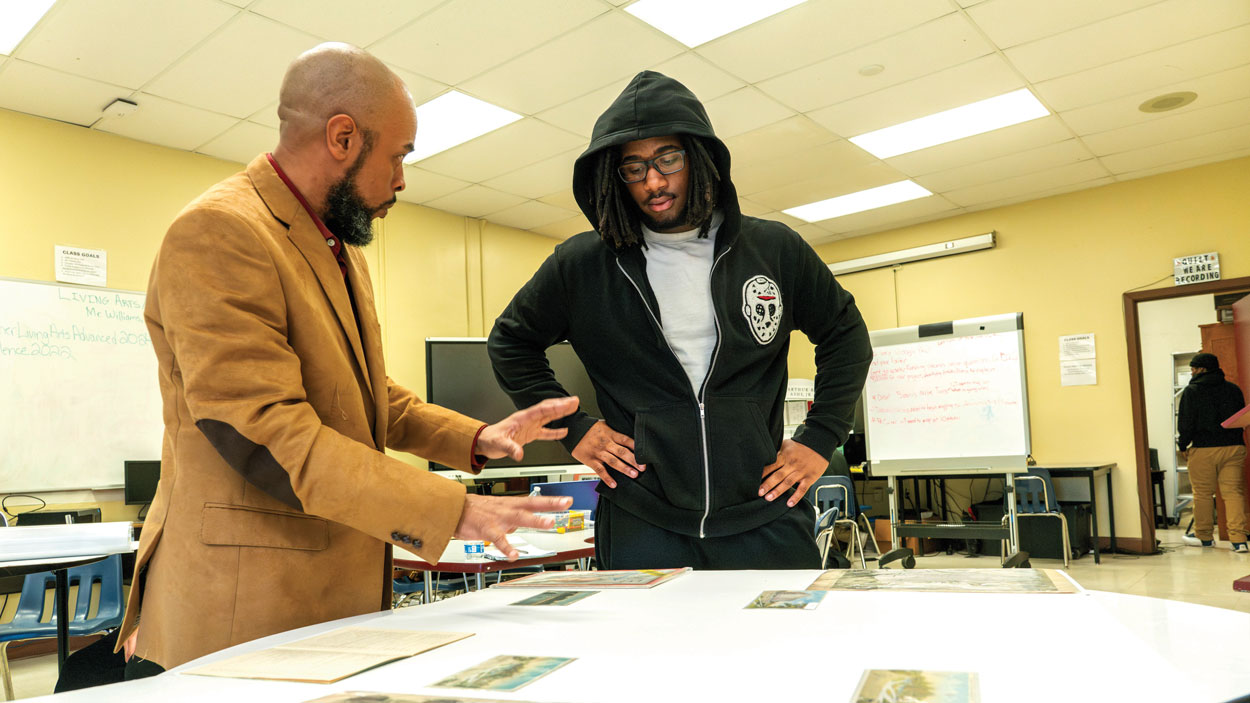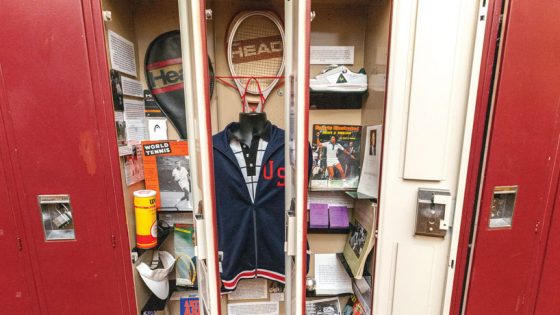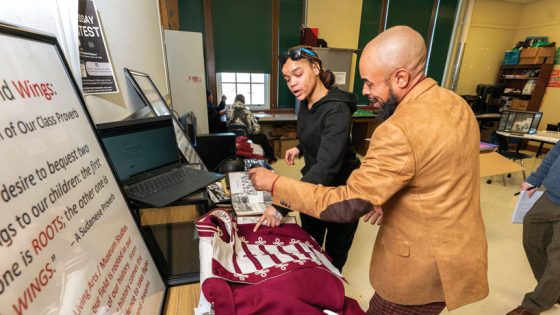
Mack Williams, a graduate research assistant in the Department of History, helps a student with his National History Day project at Sumner High School. Williams teaches a new elective museum studies course in which Sumner students research personal and local history, create public exhibits and learn museum and cultural heritage career skills. (Photos by Derik Holtmann)
Mack Williams answers questions from all corners of the lively Sumner High School classroom as he moves from table to table, project to project.
His students are engaged and working cooperatively at half a dozen spaces, while Williams lends a hand with their history projects, helping nail down a timeline and sorting through Sumner yearbooks of days gone by.
The space, a former art classroom, is specifically designed with an open layout to facilitate working in groups. It has also been transformed into a veritable multimedia production house, with two 3-D printers on one wall, a bank of computers on another, a CNC router machine to create vector-based etchings in the corner and a backroom converted into a studio for video and podcast recordings.
“It’s different from any other classroom in the school,” Williams says. “It’s a different energy.”
It’s all part of the Living Arts Pathway, a new elective museum studies course in which Sumner students research personal and local history, create public exhibits and learn museum and cultural heritage career skills. The course grew from a unique community partnership between 4theVille, a community-based cultural organization working to safeguard the legacy of The Ville neighborhood, and the Museums, Heritage and Public History graduate program at the University of Missouri–St. Louis.
The course, part of a broader Arts Pathways program at the high school, is helping breathe new life into the nearly 150 year-old institution and center of Black life in St. Louis – one that only a few years ago appeared on the brink of closure.
A new beginning
Sumner High School holds a notable place in local and national history as the first high school west of the Mississippi River to educate Black students. During the 20th century, the institution produced numerous cultural luminaries such as Arthur Ashe, Chuck Berry and Tina Turner.
Despite its significance, the school was in danger of closing its doors in 2020 due to low enrollment. Two co-founders of 4theVille, Julia Allen and Thomasina Clarke, were frustrated with that possibility and decided to take action. As Sumner alumni and lifelong residents of The Ville – the historic Black neighborhood surrounding the school’s Cottage Avenue campus – they recognized its cultural and symbolic importance.
“I have yet to tell a Black history story that does not run through The Ville in some form or fashion,” says Aaron Williams, fellow 4theVille co-founder and board chairman.
4theVille rallied local arts and cultural organizations, most notably the St. Louis Shakespeare Festival, to petition the Board of Education of the City of St. Louis to spare the school. The group authored the Sumner High School Recovery Proposal, which suggested injecting arts enrichment programs into the school as a means of increasing enrollment and student engagement. The school board ultimately approved the plan going into the 2021-22 academic year, and the Sumner Advisory Board was formed to oversee the school transformation.
“We were to stand up that program by the start of the second school year,” Williams explains.
He tapped Lara Kelland, the E. Desmond Lee Endowed Professor in Museum Studies and Community History at UMSL, to help guide the development of the Living Arts Pathway. The pair enlisted Mack Williams, a graduate research assistant in the Department of History, to finalize the curriculum and teach the course at Sumner.
A promising start
Mack Williams was confident he could attract students to museum studies by connecting with them on a personal level, and he was right. The popularity of the course grew by word of mouth during its first year, and soon the class roll was filled. The inaugural cohort also saw early success.
“We had seven projects entered into the National History Day competition for our first year, and five of those seven finished top five in their respective categories,” he says. “Our students, they have the confidence going into this space this year where they know that they belong. They know they can do well. They have a track record of doing well, and we have the experience to build on.”

Artifacts and photos of tennis star and Sumner High School alum Arthur Ashe Museum are showcased in a locker exhibit at the high school. Five lockers are dedicated to prominent alumni and are outfitted with plexiglass and lights. The displays include photos, documents from the school archive, digital videos and digital story maps accessible via QR codes.
Because of student demand, Williams is teaching two sections this year, a beginner class with 15 students and an intermediate class with 20 students. He adds that he hasn’t had a single disciplinary issue in his classroom in a year and a half.
Those results are no accident. They stem from the high expectations Williams sets early with his students, which are further reflected in the class motto, “Excellence as expected.” Principal Ronda Wallace has witnessed the transformative effect of that approach.
“It’s definitely made an impact on bringing out their natural talents,” Wallace says. “It also played a part in our increased enrollment and our decrease in discipline because they’re really focused on the research. They get focused, and they get excited. Once you provide a program where students are excited, then magic happens.”
An inside-out approach
The Living Arts Pathway curriculum is designed carefully to develop buy-in from students. Williams says he identified an “inside-out approach” that starts with a family history project and gradually increases students’ reach into the community.
“Each project subsequently expands their exposure,” Williams says. “One of the areas that we wanted to focus on to help facilitate that was genealogy, so we explored the connections between the students and their family journey to get here and make the correlation between that and the Great Migration as a part of the larger African American experience. In addition to that, we started working on projects that connected them with the history of the school.”
The students have been empowered to find new and innovative ways to preserve the legacy of Sumner. One of their first successful endeavors involved reimagining Sumner’s “Hall of Fame” – a stretch of hallway with portraits of famous alumni.
“I took our students out into the hallway to look at those portraits, and I challenged them to reexamine what they would do to incorporate a better understanding of who these people are and to better express that in honoring them in the hallways,” Williams says. “We brainstormed with that idea and came up with preserving the legacy of our Hall of Fame alumni through transitioning unused locker spaces into museum display spaces.”
Five lockers are dedicated to prominent alumni and are outfitted with plexiglass and lights. The displays include photos, documents from the school archive, digital videos and digital story maps accessible via QR codes. Sophomore Romell Calhoun enjoyed using artifacts connected to Ashe, Turner and Grace Bumbry to tell their stories and says the project opened his eyes to how many great people came out of Sumner.
Students have also begun curating an oral history archive, recording interviews with Sumner alumni from all walks of life. Senior Zea‘Neya Rhone enjoys conducting interviews and has embraced her role as a documentarian.
“This class helps me see the perspective of Sumner alumni,” she says. “You get to make your own history while learning about history.”

Mack Williams assists a student with a project about Sumner High School alum Warren Bass, the first Black baton twirler at the University of Missouri–Columbia.
The interviews also provided Jordan Stewart with an opportunity to develop his skills as a photographer and videographer.
“I didn’t expect to be learning to work a camera the way I know how now,” he says. “I’m a jack of all trades here. I do everything. I’ve recorded interviews; I’ve taken some nice pictures.”
Students are also free to explore individual passions through their National History Day projects. They have the option to create a documentary video, visual exhibit, research paper, performance or website for the annual competition. Topics vary widely from the legacy of influential rapper 2Pac to Calhoun’s project on the untold story of a Black scientist who began developing rocket schematics in the 1920s.
By telling these stories, the students are cultivating valuable, transferable skills and beginning to see a place for themselves in the museum studies field and beyond. For many, college has become not just a reality but an expectation.
Calhoun says understanding the history of Sumner High School inspires him to pursue his goal of attending the Massachusetts Institute of Technology to study aerospace engineering.
“It made me feel like I can actually do something with my life,” Calhoun says. “They were people who came out of Sumner, then I’m going to be someone who eventually comes out of Sumner. So that means I have a chance of making it and making a great impact on the world just as the people before me did.”














